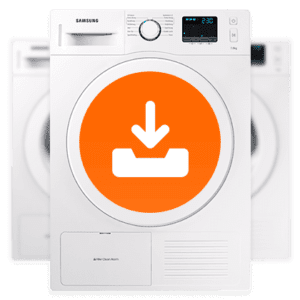Different types of drip trays for your washing machine
If you are worried that your washing machine will leak and cause water damage in your home, then it might be a good idea to install a drip tray. In this section, we’ve listed what drip trays are available, so you can decide which one is best for your situation and needs.
Washing machine with built-in drip tray
Newer washing machines often come with a built-in drip tray, which ensures that leaked water is immediately collected in a waterproof container. This prevents other parts of the washing machine from being exposed to the water and being damaged as a result. Often, washing machines with a built-in drip tray also have a bottom sensor, which ensures that the flow of water is stopped the moment the machine leaks water.
This solution does not provide protection if the washing machine’s hose starts leaking from the outside. Only if there is a defect on the inside of the washing machine will a built-in drip tray suffice. For example, if the water supply valve to the washing machine leaks, then a built-in drip pan will not provide enough protection.
Washing machine with an external drip pan
If your washing machine does not come with a built-in pan to collect the water, then you can also choose to install one yourself. These are simple plastic trays that can be purchased online or at a hardware store for a few bucks.
Please be aware of the dimensions when purchasing, most drip trays are 60 cm wide and 60 cm long (or 65×65), with a height of about 10 cm. A drip tray of this size fits under most washing machines and is big enough to catch the water of one wash. You can also choose a drip pan that is wider, longer or higher, but in practice that is not necessarily more economical.
External Drip Pan With Drain
The disadvantage of an external washing machine drip pan is that your machine will be in water for a while. For example, suppose you run a wash at night and only find out in the morning that your washing machine has leaked, then it is possible that the material of the machine has suffered water damage. Your floor may be protected but the electrical components inside your machine may be damaged beyond repair. A solution to this problem is a drip tray with a drain, which you can easily connect to your water drain. This keeps the water out of the drip tray and reduces the chance of damage to the machine itself.
You should always check to make sure the drip tray is dry. Because the water does not stay in it, there is a good chance that you will overlook a leak.
Other ways to prevent water damage
If you have decided that a washing machine drip tray is not quite what you are looking for, there are also some other things you can do to prevent water damage:
Leak protection
Some new washing machines already come with an aqua stop, which ensures that the machine will stop rinsing the moment it leaks water. With a built-in float system, the machine keeps track of the water level and the moment the water level decreases too quickly, the machine will shut off automatically.
It is not possible to build this system into an existing washing machine, so you will need to invest in a new washing machine.
Supply hose with leak lock
What you can do with an existing washing machine is install a hose with a leak lock. You attach this between the water inlet and the water outlet of your washing machine. With a leak lock the water goes through a double hose and when the inner hose breaks, the water is collected by the outer hose. The moment the water is in the outer hose, a lock is activated preventing any new water from being supplied.
The disadvantage of this method is that it is only effective if your washing machine’s hose is leaking, if something is leaking inside the machine, this solution will not prevent you from getting a leak.
Water Stop
You can also install your own water stop between your washing machine’s hose and the faucet. This has different numbers on the inside, which are equal to the amount of water that can flow through it. If you set the water stop to 5 litres, the supply of water will automatically stop when more than 5 litres has gone through.
With this solution, you should note that the maximum amount of water will still be supplied in the event of a leak, so the leakage is only limited and not stopped.
So, a washing machine drip tray, yes or no?
A washing machine drip tray is certainly a good idea if you’re worried that your washing machine will leak, but it’s an even better idea to combine it with several other ways to prevent or limit water damage.
Always think about the different types of water damage your washing machine can cause and make sure you’re protected against all of them. A drip tray, for example, will help to prevent a leak from the inside of the machine, while a leak lock will protect you from water leaking outside the washing machine. It would be a shame if you only use one of these ways and then end up with water damage because your washing machine leaks in a different place.

